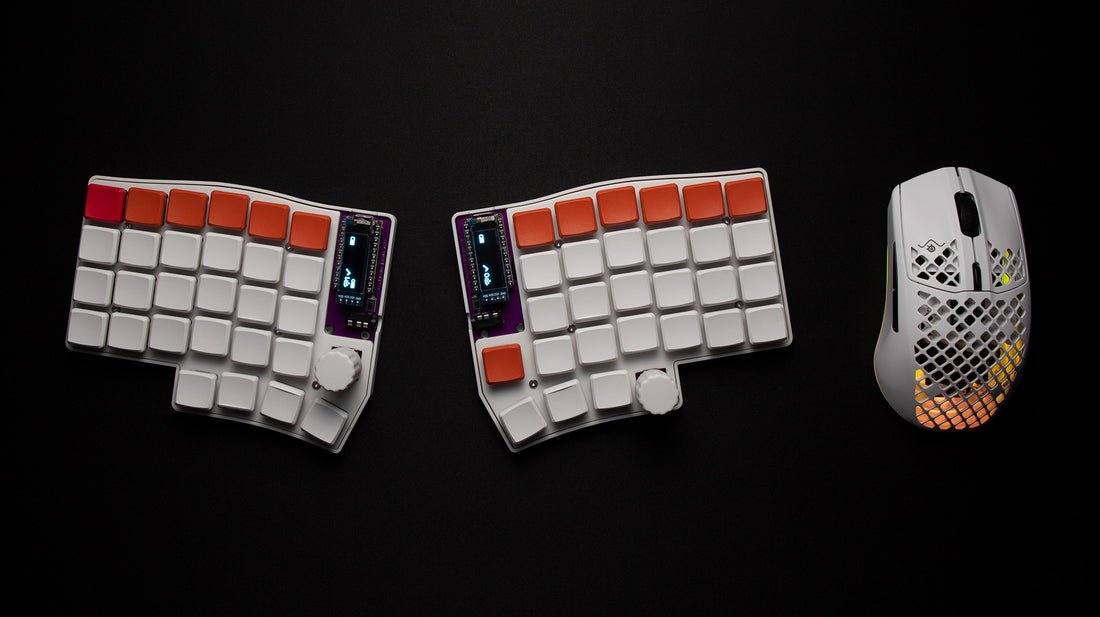
Let's Dial into Leeloo's Case
Share
Since the beginning of February, I've been working on Leeloo's firmware for QMK and ZMK. I'm quite happy where things are at and I feel ready to prepare the PRs; I hope to submit them very soon to their respective projects.
Yet, over the past week, I changed pace a little, and shelved the firmware projects.
What happened!?
I focused on working with Leeloo in both wired (QMK) and wireless (ZMK) modes—to test the firmware and the overall build quality of Leeloo itself. At the same time, I've had two items on my To Do list that I wanted to attack, and I was able to complete them this week. I'm proud to share that Leeloo now has:
- Dials for EC11 Rotary Encoders; and,
- a Case for the left and right shields.
[Okay, and greedily speaking, I wanted to play with my 3D printer.]
Dialling in!
Albeit, rotary encoders aren't for everyone, I've enjoyed using them in applications like KiCAD, FreeCAD, Adobe Photoshop, Final Cut Pro, and any app that views or edits documents. My current version of Leeloo has two encoders. One just under the left OLED; and the other on the far right of the mods row—which is my favourite.
It's my all-time favourite because it's like my very own "Easy" button that I can bop. It's higher than all other keys, and I use it to save and close my current document.
Type, type, type, type, type...bop! [Document saved, and closed. Coffee time!]
At the same time, it's like a homing key for my backspace button. I know I can tuck my thumb in and to the right as far as I need to touch the dial, and then press down—confidently knowing that I'll backspace, or delete-in-place if I press Raise at the same time.
But, macros and combos aren't the real reason why Leeloo has a new dial. It's because I've found it very difficult to find a dial that fits Choc spacing; let alone, press fit, so that there isn't a drill, tap, and set screw on the outside of the dial itself—aesthetically, I feel the set screw takes away from the overall look of the dial. To solve the problem, I designed a dial for Leeloo, which I hope to produce in a variety of different materials: wood, aluminium, and brass.
There'll be two different heights, one for 20mm shafts (Box switches), and the other for 15mm shafts (Choc switches).
What's up with Leeloo's Case?
It has walls! As much as I like plate cases—especially for LED enabled keyboards—I find the draw back to them is that dust and fluffies get in-between the case layers.
In Leeloo's current case—yes, pun fully intended—LEDs are not incorporated into the design...but, soon, and to be continued in another blog. Because of this, I felt it was an opportunity to design a more encapsulated container for Leeloo...to keep things a little more dust free.
There are two variations; one for Choc switches (as seen in the assocaited blog picture), and the second variation for Box switches. The difference is in the wall height.
Not unlike Leeloo's dial, I plan on producing the cases in a variety of different materials: wood, aluminium, and brass.
How do you feel about Leeloo and its progress?
If you're interested in more information, or would like to be on the notification list for when Leeloo will be available, please contact us.
Until next time,
Clickety Split
For the love of split keyboards.
